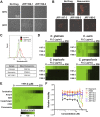Oxadiazole-Containing Macrocyclic Peptides Potentiate Azole Activity against Pathogenic Candida Species
- PMID: 32269162
- PMCID: PMC7142304
- DOI: 10.1128/mSphere.00256-20
Oxadiazole-Containing Macrocyclic Peptides Potentiate Azole Activity against Pathogenic Candida Species
Abstract
Opportunistic pathogens of the genus Candida reign as the leading cause of mycotic disease and are associated with mortality rates greater than 40%, even with antifungal intervention. This is in part due to the limited arsenal of antifungals available to treat systemic fungal infections. Azoles have been the most widely deployed class of antifungal drug for decades and function by targeting the biosynthesis of ergosterol, a key component of the fungal cell membrane. However, their utility is compromised by their fungistatic nature, which favors the development of resistance. Combination therapy has the potential to confer enhanced efficacy as well as mitigate the evolution of resistance. Previously, we described the generation of structurally diverse macrocyclic peptides with a 1,3,4-oxadiazole and an endocyclic amine grafted within the peptide backbone. Importantly, this noncanonical backbone displayed high membrane permeability, an important attribute for compounds that need to permeate across the fungal cell wall and membrane in order to reach their intracellular target. Here, we explored the bioactivity of this novel chemical scaffold on its own and in combination with the azole fluconazole. Although few of the oxadiazole-containing macrocyclic peptides displayed activity against Candida albicans on their own, many increased the efficacy of fluconazole, resulting in a synergistic combination that was independent of efflux inhibition. Interestingly, these molecules also enhanced azole activity against several non-albicans Candida species, including the azole-resistant pathogens Candida glabrata and Candida auris This work characterizes a novel chemical scaffold that possesses azole-potentiating activity against clinically important Candida species.IMPORTANCE Fungal infections, such as those caused by pathogenic Candida species, pose a serious threat to human health. Treating these infections relies heavily on the use of azole antifungals; however, resistance to these drugs develops readily, demanding novel therapeutic strategies. This study characterized the antifungal activity of a series of molecules that possess unique chemical attributes and the ability to traverse cellular membranes. We observed that many of the compounds increased the activity of the azole fluconazole against Candida albicans, without blocking the action of drug efflux pumps. These molecules also increased the efficacy of azoles against other Candida species, including the emerging azole-resistant pathogen Candida auris Thus, we describe a novel chemical scaffold with broad-spectrum bioactivity against clinically important fungal pathogens.
Keywords: Candida; Candida albicans; antifungal; azole; fluconazole; fungal pathogens; macrocycle; oxadiazole.
Copyright © 2020 Revie et al.
Figures


References
Publication types
MeSH terms
Substances
Grants and funding
LinkOut - more resources
Full Text Sources
Other Literature Sources

